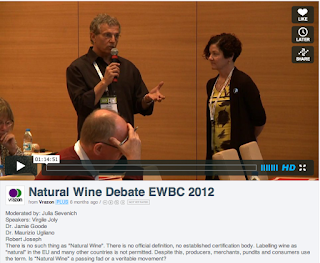In response to a few requests, here are a few brief thoughts about - and images of - last week's Vinexpo.
Before doing that, however, maybe it's worth my providing a little personal background - and some context (please do feel free to skip this bit). I've been going to Vinexpo for so long that I can remember the vigorous debates of the early days over whether the fair should be limited to Bordeaux, or France, or whether - and this was highly controversial - wines from other countries should be allowed within its doors. Having attended the exhibition since the early 1980s and generally having been around for a long time almost inevitably means that I know a lot of the people who I'm likely to see there, so the show offers a great opportunity to catch up with them. Finally, since 2005, when I crossed the line from consumer wine-writing to wine production and industry analysis, I have viewed these events in a different way, with less of an obsessive focus on the quality of the liquid on show, and more of an holistic appreciation of the business as a whole.
Before doing that, however, maybe it's worth my providing a little personal background - and some context (please do feel free to skip this bit). I've been going to Vinexpo for so long that I can remember the vigorous debates of the early days over whether the fair should be limited to Bordeaux, or France, or whether - and this was highly controversial - wines from other countries should be allowed within its doors. Having attended the exhibition since the early 1980s and generally having been around for a long time almost inevitably means that I know a lot of the people who I'm likely to see there, so the show offers a great opportunity to catch up with them. Finally, since 2005, when I crossed the line from consumer wine-writing to wine production and industry analysis, I have viewed these events in a different way, with less of an obsessive focus on the quality of the liquid on show, and more of an holistic appreciation of the business as a whole.
Striking advertisement for a dynamic, multi-country
brand
2013 was a "quiet" year. There was little real buzz about anything really. In 2011 at the previous event, there was 2010 and 2009 Bordeaux to talk about; this year, there was 2011 and 2012 not to talk about. Two years ago, China was still "hot". Now it is generally considered to have come off the boil.
Chinese spirit stand - one of the biggest in the whole fair
There were plenty of Chinese visitors, but they are now more of the mainstream of the event: they are no longer as exotic as they were.
The show felt very "French". There was no Australian stand (since the year when the air conditioning failed and the wines were cooked) and the other New World stands did not make a huge impact on the fair as a whole.
There was little that was new. NPD - New Product Development - was notable for its absence, with the exception of Amorim's screw-in Helix corks.
Giant sculptures - and umbrella-wielding Vinexpo-goers
heading across the bride over le Lac
And of course, it was rainy. Very rainy. Tropically rainy at times. This meant that there were fewer people outside the fair - and also revealed how much quieter - in numerical terms - Vinexpo 2013 was. Visitors to previous events will remember the nightmare of trying to make one's way along the crowded aisles from one end of the hall to the other. The only sensible way to do this was to leave the building. Not this time. The building was definitely less full.Vinexpo's statistics may not reflect this, but the anecdotal evidence is clear: the car park was far less full, and it took far less time to queue for a sandwich at lunchtime. Hotels reported late cancellations, and had rooms for those who wanted to book one at late notice.
Despite all of this, logistics remain a nightmare. Negociating the traffic in the morning or getting out of the car park can take what seems to be a lifetime. There were, however, signs that Bordeaux's famous trams will reach Vinexpo in two years time, finally making the exhibition as easy to get to and from as Messe Dusseldorf is from its city centre.
Russian vodka stand. On occasion manned (!) by
- slightly - more dressed ladies than the ones in
the posters
If there were fewer people, there was no suggestion that the "right" people were not there. The exhibitors I talked to were all happy with the meetings they had.
However, there were many questions over the duration of the fair. My humorous suggestion that Vinexpo could lose two of its five days and give one to ProWein (which currently runs for three) was taken surprisingly seriously.
In a nutshell, ProWein is now undeniably the business event, at which the real sales are made. Vinexpo remains the networking event - the one at which the principals of businesses are more likely to appoint agents and discuss mergers and acquisitions.
Poster on road away from the fair. Traffic
allowed plenty of time to take down that number




































